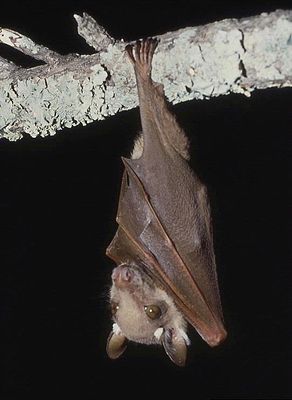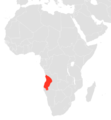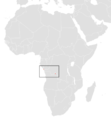Epomophorus
| Epomophorus | ||||||||||||
|---|---|---|---|---|---|---|---|---|---|---|---|---|

Wahlberg epaulette bat ( Epomophorus wahlbergi ) |
||||||||||||
| Systematics | ||||||||||||
|
||||||||||||
| Scientific name | ||||||||||||
| Epomophorus | ||||||||||||
| Bennett , 1836 |
Epomophorus is a genus of epaulette bats found in Africa .
description
Species of the genus Epomophorus vary greatly in size, with a weight range of 40 to 120 g and a head-torso length of 125 to 200 mm. The fur is gray to yellow-brown, depending on the species, with a white patch at the base of the ears. Males also have the tufts of hair typical of epaulette bats on the shoulders, where there are sac-like glands.
Way of life
Epomophorus species are found in forests and savannahs, preferring forest edges. During the day, the animals hang in hollow trees and dense foliage. The hanging places are often brightly lit and the groups are clearly visible from the outside. Some species, such as the Wahlberg epaulette bat, change their hanging place daily, with a distance of up to 4 km to the nocturnal feeding place. The food spectrum includes figs , guava , mangoes and bananas , as well as nectar and flowers. Some species like E. labiatus seem to migrate further distances in search of food. Their diet makes the genus an important seed disperser and pollinator of various plants.
Types and distribution
- Angola epaulette bat ( E. angolensis )
- Ansell's epaulet bat ( E. anselli )
- Peters' epaulette bat ( E. crypturus )
- Gambian epaulet bat ( E. gambianus )
- Sanborn epaulette bat ( E. grandis )
- Ethiopian epaulet bat ( E. labiatus )
- Tiny epaulette bat ( E. minumus )
- Wahlberg epaulette bat ( E. wahlbergi )
Distribution area of E. angolensis
Distribution area of E. anselli
Distribution area of E. crypturus
Distribution area of the Gambian epaulette bat ( E. gambianus )
Distribution area of E. grandis
Distribution area of E. labiatus
Distribution area of E. minumus
Distribution area of the Wahlberg epaulette bat ( Epomophorus wahlbergi )
Danger from humans
With the exception of the potentially endangered species E. angolensis , all species of the genus Epomophorus are classified as harmless by the IUCN . An increasing problem, however, is the destruction of the habitat, especially the hanging places and the decline in forage plants.
literature
- Ronald M. Nowak: Walker's Bats of the World. Johns Hopkins University Press, Baltimore MD 1994, ISBN 0-8018-4986-1 .







